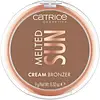What's inside
What's inside
 Key Ingredients
Key Ingredients

 Benefits
Benefits

 Concerns
Concerns

 Ingredients Side-by-side
Ingredients Side-by-side

Ethylhexyl Palmitate
EmollientDimethicone
EmollientCellulose
AbsorbentAluminum Starch Octenylsuccinate
AbsorbentC10-18 Triglycerides
EmollientSynthetic Wax
AbrasiveKaolin
AbrasiveDimethicone Crosspolymer
Emulsion StabilisingSilica Dimethyl Silylate
EmollientButyrospermum Parkii Butter
Skin ConditioningPropylene Carbonate
SolventGlyceryl Caprylate
EmollientPentaerythrityl Tetra-Di-T-Butyl Hydroxyhydrocinnamate
AntioxidantCitric Acid
BufferingAluminum Hydroxide
EmollientCI 77491
Cosmetic ColorantCI 77492
Cosmetic ColorantCI 77499
Cosmetic ColorantCI 77891
Cosmetic ColorantEthylhexyl Palmitate, Dimethicone, Cellulose, Aluminum Starch Octenylsuccinate, C10-18 Triglycerides, Synthetic Wax, Kaolin, Dimethicone Crosspolymer, Silica Dimethyl Silylate, Butyrospermum Parkii Butter, Propylene Carbonate, Glyceryl Caprylate, Pentaerythrityl Tetra-Di-T-Butyl Hydroxyhydrocinnamate, Citric Acid, Aluminum Hydroxide, CI 77491, CI 77492, CI 77499, CI 77891
Phenyl Trimethicone
Skin ConditioningSilica
AbrasiveAluminum Starch Octenylsuccinate
AbsorbentPolymethyl Methacrylate
Polyethylene
AbrasiveMicrocrystalline Wax
Emulsion StabilisingPhenoxyethanol
PreservativeDiethylhexyl Syringylidenemalonate
Skin ProtectingTocopheryl Acetate
AntioxidantCaprylyl Glycol
EmollientArgania Spinosa Kernel Oil
EmollientCaprylic/Capric Triglyceride
MaskingCI 77491
Cosmetic ColorantCI 77492
Cosmetic ColorantCI 77499
Cosmetic ColorantCI 77891
Cosmetic ColorantCI 42090
Cosmetic ColorantCI 17200
Cosmetic ColorantPhenyl Trimethicone, Silica, Aluminum Starch Octenylsuccinate, Polymethyl Methacrylate, Polyethylene, Microcrystalline Wax, Phenoxyethanol, Diethylhexyl Syringylidenemalonate, Tocopheryl Acetate, Caprylyl Glycol, Argania Spinosa Kernel Oil, Caprylic/Capric Triglyceride, CI 77491, CI 77492, CI 77499, CI 77891, CI 42090, CI 17200
Ingredients Explained
These ingredients are found in both products.
Ingredients higher up in an ingredient list are typically present in a larger amount.
Aluminum Starch Octenylsuccinate is a synthetic powder used as an absorbent, thickener, and anti-caking agent.
As an absorbent, it is great at mattifying skin by soaking up the oil. This is why you'll find it in a range of products from makeup to moisturizers.
This ingredient is considered a modified starch. Starch can also be found naturally in plants.
One study from 1991 found that 5% of this ingredient enhanced titanium dioxide SPF by as much as 40%. The study found 1% titanium dioxide had a 5.6 SPF and adding 5% of aluminum starch octenylsuccinate boosted it to an SPF of 8.1
Although “aluminum” in an ingredient name can raise red flags for some consumers, the form and usage context matter significantly. For typical topical applications, there is no substantial evidence of health risks - such as cancer, neurotoxicity, or systemic “aluminum overload.”
Learn more about Aluminum Starch OctenylsuccinateCi 77491 is also hydrated iron III oxide. It's sole purpose is to give a red/pink hue to products.
Iron III oxides are classified as inorganic chemicals for coloring.
Synthetically created Ci 77491 is considered safer than those naturally found. This is because the synthetically created version may contain less impurities. Iron oxides are generally non-toxic and non-allergenic.
Learn more about CI 77491Ci 77492 is also hydrated iron III oxide. It's sole purpose is to give a yellow hue to products.
Iron III oxides are classified as inorganic chemicals for coloring.
Synthetically created Ci 77492 is considered safer than those naturally found. This is because the synthetically created version may contain less impurities. Iron oxides are generally non-toxic and non-allergenic.
Learn more about CI 77492Ci 77499 is also hydrated iron III oxide. It is created from mixing red and black iron oxides. This helps give shades of darkness to a product.
Iron III oxides are classified as inorganic chemicals for coloring.
Ci 77891 is a white pigment from Titanium dioxide. It is naturally found in minerals such as rutile and ilmenite.
It's main function is to add a white color to cosmetics. It can also be mixed with other colors to create different shades.
Ci 77891 is commonly found in sunscreens due to its ability to block UV rays.
Learn more about CI 77891